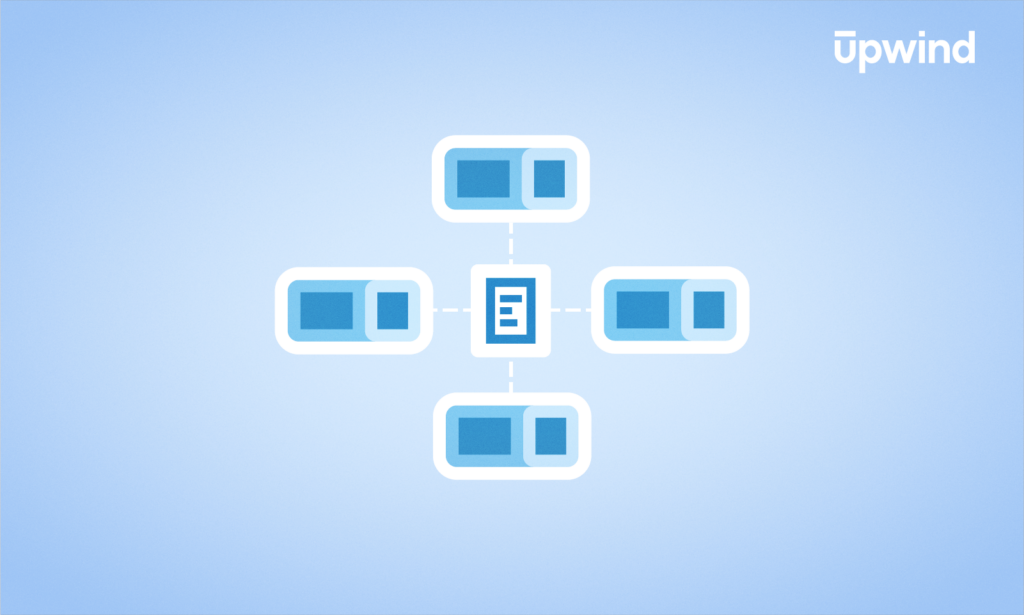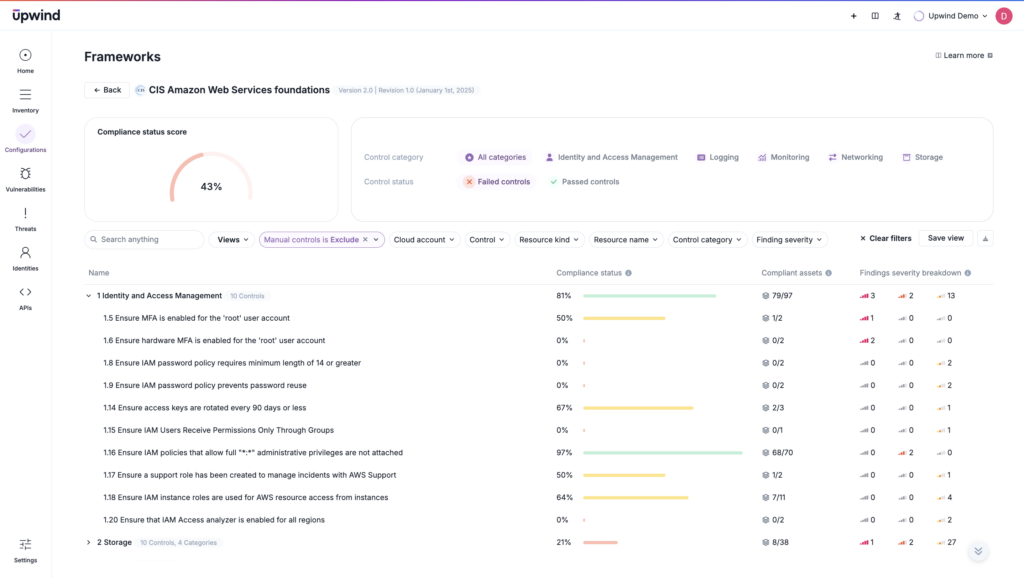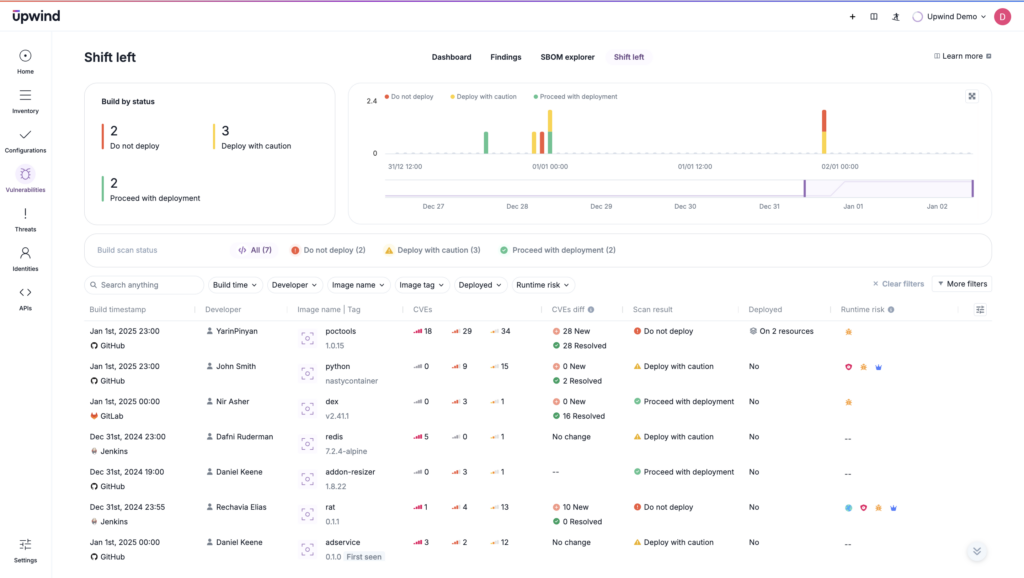
How can teams achieve infrastructure security beyond misconfigurations? Can IaC scan for compliance benchmarks? Can it distinguish between a hardcoded secret and a placeholder? We’re going beyond the basics of infrastructure as code (IaC) scanning to break down some tangible trade-offs and deeper questions that security teams will face as they work to perfect the firehose that is often the reality of the software development lifecycle – from interdependencies to compliance management.
What is IaC Scanning?
IaC scanning refers to pre-deployment security checks for issues like misconfigurations, security risks, dependency issues, permissive roles, and unsecured network connections of code-based configuration files called IaC templates. IaC templates are used in the setup of infrastructure, from servers to networks, databases, and permissions. Written in languages like JSON, YAML, or HCL, IaC templates act as blueprints for automating the provisioning and management of infrastructure so it’s easily repeatable.
The goal of IaC Scanning is to detect issues before software is built and deployed, when addressing flaws could take longer and incur higher costs.
IaC scanning includes the following key components:
- Error and Security Checks
IaC scans detect misconfigurations and vulnerabilities, such as open ports or publicly accessible resources. - Compliance Validation
Scans make sure that templates align with industry or organizational standards (e.g., CIS Benchmarks, HIPAA). - Secret Detection
Scans flag hardcoded sensitive information like passwords or API keys for removal. - Actionable Remediation
IaC scans offer clear, practical recommendations to fix identified issues. - Integration with CI/CD Pipelines
IaC scanning is typically automated during development workflows to catch problems early.
IaC scanning helps teams “shift left” by identifying vulnerabilities early in the software development lifecycle (SDLC). By catching issues like misconfigurations, hardcoded secrets, or compliance violations at the code level, teams can resolve problems before they propagate into live environments.
According to Gartner, comprehensive security solutions like CNAPPs don’t inherently offer IaC as part of their suite of security tools, but the category definition overlaps with a number of capabilities of IaC tools, like security guardrails and compliance management. Further, many CNAPPs do offer IaC.
But while IaC templates are critical for automating cloud infrastructure, they don’t protect against:
- Configuration Drift: When runtime environments deviate from what’s defined in IaC templates.
- Runtime Threats: Vulnerabilities, attacks, or misconfigurations that emerge after deployment.
This is why teams using IaC templates can benefit from incorporating IaC into their CNAPP solution, securing not just the templates but also the live infrastructure they create.

While IaC scanning secures infrastructure before deployment, CNAPPs with IaC scanning provide end-to-end visibility and runtime security, addressing the gaps in static template analysis. By integrating IaC scanning with runtime monitoring, CNAPPs:
- Correlate IaC findings with runtime behaviors to prioritize real-world risks.
- Detect and mitigate configuration drift or unauthorized changes.
- Provide unified policy enforcement across pre-deployment and live environments.

What are the Benefits and Challenges of IaC Scanning?
The rise of IaC for automating infrastructure deployment has made security and compliance checks a key of the development process. And IaC scanning is becoming more common as more organizations adopt cloud infrastructure and prioritize automation. Finally, with the rise in supply chain attacks and misconfigurations being a leading cause of cloud breaches, IaC scanning is increasingly viewed as essential rather than optional.
Consolidation is part of the move toward IaC ubiquity — platforms like CNAPPs integrate IaC scanning alongside runtime security and compliance for broader adoption.
Even on its own, IaC scanning offers a proactive layer of security by identifying misconfigurations, vulnerabilities, and compliance gaps in infrastructure templates before deployment. Here are some of the key benefits of IaC scanning:
- Preemptive Risk Mitigation
By shifting left, IaC scanning identifies and resolves issues like overly permissive IAM roles or open ports before infrastructure is provisioned. This minimizes the attack surface and reduces the risk of downstream vulnerabilities. - Enforced Consistency Across Environments
Scanning ensures that every IaC template adheres to security policies and best practices for uniform configurations across development, staging, and production environments. - Scalability in Securing Complex Architectures
For multi-cloud or hybrid environments with hundreds of IaC templates, automated scanning helps enforce policies consistently across clouds. - Custom Policy Validation
Some IaC scanning tools (and CNAPPs like Upwind) let organizations define and enforce custom policies (e.g., encryption mandates for storage buckets or zero-trust networking principles), ensuring infrastructure configurations align with unique security requirements. - Simple CI/CD Integration
Modern tools integrate directly into CI/CD pipelines, providing near-instant feedback to developers without disrupting workflows. This enables teams to embed security checks into an agile workflow. - Contextual Insights for Prioritization
Scanners can provide contextualized findings, highlighting risks based on environmental factors or likely exploitation paths. This reduces alert fatigue and reduces false positives. CNAPPs may use runtime insights based on machine learning to filter more accurately based on an organization’s specific environment.
Challenges of IaC Scanning
- High False Positives
Many scanners flag issues that may not pose real risks in the intended environment, leading to unnecessary remediation. With IaC’s typical static analysis, distinguishing critical issues from noise can be difficult. - Limited Runtime Context
IaC scanning focuses exclusively on pre-deployment templates. It cannot account for runtime factors like configuration drift, real-time access patterns, or active threats. That limitation necessitates complementary runtime security tools, such as CNAPPs to fully secure IaC. - Dynamic and Evolving Policies
Security requirements don’t stand still; they evolve with organizational changes, emerging threats, and compliance updates. But scanners can’t always adapt. - Complexity in Multi-Cloud and Hybrid Setups
Multi-cloud architectures often involve different IaC frameworks and tools, which creates the possibility of inconsistent scanning policies and outputs. - Integration and Workflow Disruption
Embedding IaC scanning into developer workflows without slowing down deployments requires careful tool selection and process design. Poorly integrated tools can create friction. - Limited Detection of Emerging Risks
Scanners rely on predefined rules and signatures, so they can’t detect novel threats or complex misconfigurations introduced indirectly through dependencies.
The bottom line? IaC is an essential, but not stand-alone, solution. IaC scanning offers proactive risk prevention by catching misconfigurations, security flaws, and compliance issues early in the software development lifecycle (SDLC) before infrastructure is provisioned.
However, the effectiveness of IaC scanning is inherently limited by its static nature. It lacks the runtime context needed to assess how infrastructure and resources are actually used in live environments. It does not help account for configuration drift, zero-day vulnerabilities, or emergent threats that arise post-deployment. And contextualized findings in IaC scanning are often generic, so they can’t help teams prioritize risks.
Given the advantages and disadvantages, is IaC the best choice?
Adjacent Tools and Concepts to Consider Alongside IaC Scanning
While IaC scanning is key to pre-deployment security, it doesn’t often operate in isolation. Adjacent tools complement IaC scanning by addressing issues across the full software development and runtime lifecycle. Here’s a breakdown:
| Tool/Concept | Description | How It Relates to IaC Scanning |
| Cloud Security Posture Management (CSPM) | Monitors and remediates cloud misconfigurations in live environments. | CSPM identifies post-deployment risks that IaC scanning might miss, such as drift from IaC templates or changes made outside automation. |
| Cloud Workload Protection Platforms (CWPP) | Secures workloads, including VMs, containers, and serverless, through runtime monitoring and threat detection. | CWPP adds a layer of runtime protection, addressing vulnerabilities that may not be apparent in static IaC templates. |
| Runtime Threat Detection | Identifies and mitigates active threats in live cloud environments using runtime security like anomaly detection and behavioral analysis. | Complements IaC scanning by monitoring for runtime anomalies like unusual access patterns and privilege escalations. |
| Dependency Scanning | Analyzes third-party libraries and modules for vulnerabilities before and during deployment. | Ensures external dependencies referenced in IaC templates or related applications are secure. |
| Policy-as-Code | Encodes security and compliance requirements into enforceable policies that apply across the CI/CD pipeline and runtime. | Enhances IaC scanning by ensuring that both templates and live environments follow consistent security rules. |
| Version Control Systems (e.g., Git) | Tracks changes to IaC templates and configuration files. | Supports IaC scanning by ensuring auditability and enabling the roll-back of insecure configurations. |
| Orchestration and Automation Tools (e.g., CI/CD) | Automates the deployment of IaC templates and integrates security checks, including IaC scanning, into the pipeline. | Provides the framework for embedding IaC scanning and other security tests into the teams’ workflows. |
The relationship between IaC scanning and these related tools lies in their complementary strengths and shared goal of securing cloud-native environments. Each tool or concept addresses gaps or limitations in others, forming an interconnected security strategy, which can add to a layered security strategy, so long as strategists avoid redundancies. Here are the key areas to cover:
Pre-Deployment vs Post-Deployment Security
IaC scanning primarily operates before infrastructure is provisioned, ensuring configurations follow security policies and compliance standards. However, post-deployment tools like Cloud Security Posture Management (CSPM) and Cloud Workload Protection Platforms (CWPP) pick up where IaC scanning leaves off.
CSPM mitigates risks from configuration drift, where live environments deviate from the original IaC templates due to manual updates or system changes. Further, CWPP focuses on workload-level protection during runtime, identifying vulnerabilities in applications or containers that are invisible in static IaC analysis.
Static vs Dynamic Risk Detection
IaC scanning checks templates against predefined rules, making it highly effective for catching static risks. However, runtime threat detection adds dynamic context by monitoring live behaviors, such as unusual access patterns or privilege escalation attempts.
While IaC can ensure initial configurations are secure, runtime detection identifies threats from the environment in real time.
Policy Enforcement Consistency
Policy-as-Code (PaC) involves the use of code to enforce policies consistently across the pipeline and runtime. While IaC scanning validates policies during template creation, PaC extends the rules to runtime environments. CSPM tools often integrate PaC, applying the same standards used in IaC scanning to detect drift or policy violations post-deployment.
This integration unifies security policies in order to eliminate blind spots caused by siloed tools. But there are alternatives. Some CNAPPs, like Upwind, integrate runtime intelligence into the CI/CD pipeline so teams can more quickly identify and prioritize vulnerabilities during the build process, closing the traditional gap between pre- and post-deployment coordination.
Managing Dependencies and Interdependencies
IaC templates often reference external modules or third-party libraries, introducing risks that IaC scanning may overlook. Teams will need dependency scanning to analyze libraries for known vulnerabilities:
The combination prevents issues like supply chain attacks, which could arise from insecure dependencies. Dependency scanning isn’t the only approach to handling vulnerabilities in dependencies. Runtime insights, with a robust SBOM explorer, can also help teams identify vulnerabilities in their supply chain and remediate them quicker.
Automation and Integration
The effectiveness of IaC scanning depends heavily on its integration into CI/CD pipelines and Version Control Systems. It’s important to both integrate scanning into the CI/CD pipeline without slowing teams, and add version control systems to track changes to IaC templates so teams can audit, revert, or improve configurations. These systems also serve as a single source of truth, ensuring alignment between development, security, and operations teams.
Unified Platforms for Efficiency
Comprehensive platforms like CNAPPs often offer capabilities to match these complementary tools, and invariably consolidate these tools into a unified framework, simplifying management and improving visibility. By combining IaC scanning, CSPM, CWPP, and runtime threat detection, CNAPPs eliminate the need to juggle multiple tools.
Further, they make correlation simple. Runtime insights help prioritize remediation, slashing false positives and letting teams address the largest risks first.
Upwind’s Infrastructure Protection, Powered by Runtime
Infrastructure as Code (IaC) has transformed how organizations build and manage infrastructure, but it’s only one piece of the cloud-native security puzzle. IaC scanning addresses critical risks before deployment, like misconfigurations, compliance violations, and hardcoded secrets. But those tools can’t account for dynamic runtime threats, configuration drift, or emerging attack patterns. That’s when Upwind complements IaC practices, letting teams “shift left” without sacrificing runtime security.
Want to see how? Schedule a demo.
FAQ
Is IaC the same as DevOps?
No, IaC (Infrastructure as Code) and DevOps aren’t the same.
IaC is a specific practice within the broader philosophy of DevOps. It automates the provisioning and management of infrastructure through code. Using IaC, teams define infrastructure configurations in files that can be version-controlled and deployed automatically so their work adheres to DevOps principles like automation, collaboration, and continuous delivery.
DevOps, on the other hand, is an operational approach that aims to break down silos between development and operations teams to speed up software development. IaC enables DevOps, but it’s just one way these teams accomplish their goals.
Why would a customer want to scan their IaC Template?
Teams scan IaC templates to find security vulnerabilities, misconfigurations, and compliance violations before deploying infrastructure. They scan code early in the process because flaws in the template lead to insecure or non-compliant infrastructure, and fixing them early on reduces time and costs.
A customer would want to scan their IaC template for several reasons:
- Preventing Misconfigurations: IaC templates might include open ports, overly permissive IAM roles, or other risky configurations. Scanning catches issues like these before they can expose infrastructure to threats.
- Ensuring Compliance: Many organizations must adhere to regulatory or organizational standards, such as CIS Benchmarks or HIPAA. Scanning validates that templates meet requirements.
- Shifting Left: By identifying vulnerabilities in the code phase, scanning helps teams “shift left,” addressing risks early when fixes are faster and less disruptive.
- Maintaining Consistency: Scanning helps document that templates adhere to best practices.
What is the difference between IaC and SAST?
IaC (Infrastructure as Code) automates infrastructure provisioning by using code-based templates.
SAST (Static Application Security Testing) is a security practice in which teams analyze application source code or binaries for vulnerabilities and insecure coding practices. SAST identifies flaws like SQL injection, cross-site scripting (XSS), or logic errors within the application code itself.
Like IaC, SAST tools can be integrated into development workflows and CI/CD pipelines to identify these issues before the application is built or deployed. Unlike IaC, SAST targets the software running on that infrastructure.






